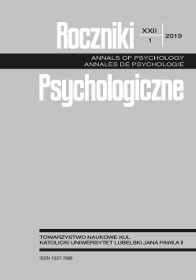When the smile is not enough: The interactive role of smiling and facial characteristics in forming judgments about trustworthiness and dominance
When the smile is not enough: The interactive role of smiling and facial characteristics in forming judgments about trustworthiness and dominance
Author(s): Michał Olszanowski, Michał Parzuchowski , Aleksandra SzymkówSubject(s): Social Sciences, Psychology, Behaviorism
Published by: Towarzystwo Naukowe KUL & Katolicki Uniwersytet Lubelski Jana Pawła II
Keywords: face; facial features; smile; similarity; impression formation; judgments of trustworthiness; judgments of dominance
Summary/Abstract: People often assess other people’s personality traits merely based on their emotional expression or the physical features of their faces. In this paper we review the evidence of biases when formulating judgments of trustworthiness and confidence from two types of facial characteristics. One line of evidence documents the influence of emotional expressions representing an individual’s motivational state and reflecting agents’ intentions. People’s judgment about the trustworthiness or attractiveness of others largely depends on the emotions expressed. The second line of evidence describes how facial appearance (e.g., cues of physical strength or resemblance to one’s own face) affects the inferences of personality traits. The two experiments described in this paper investi-gated the interplay between these two factors (i.e., facial features and emotional expression) and their combined influence on social judgments. We hypothesized and tested how both facial features conveying trustworthiness (vs. dominance) and a smiling (vs. neutral) expression influence judgments of trustworthiness and confidence (Study 1). We also tested the influence of facial resemblance in an interaction with a smiling individual when forming judgments (Study 2). We found that relatively static facial features conveying trust had more impact on judgments of trustworthiness than emotional expressions, yet emotional expressions seem to be more impactful for judgments of dominance. The results of both studies are discussed from a sociocognitive perspective.
Journal: Roczniki Psychologiczne
- Issue Year: 22/2019
- Issue No: 1
- Page Range: 35-52
- Page Count: 18
- Language: English

